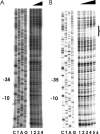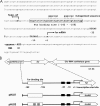Positive regulation of fur gene expression via direct interaction of fur in a pathogenic bacterium, Vibrio vulnificus
- PMID: 17237166
- PMCID: PMC1855807
- DOI: 10.1128/JB.01791-06
Positive regulation of fur gene expression via direct interaction of fur in a pathogenic bacterium, Vibrio vulnificus
Abstract
In pathogenic bacteria, the ability to acquire iron, which is mainly regulated by the ferric uptake regulator (Fur), is essential to maintain growth as well as its virulence. In Vibrio vulnificus, a human pathogen causing gastroenteritis and septicemia, fur gene expression is positively regulated by Fur when the iron concentration is limited (H.-J. Lee et al., J. Bacteriol. 185:5891-5896, 2003). Footprinting analysis revealed that an upstream region of the fur gene was protected by the Fur protein from DNase I under iron-depleted conditions. The protected region, from -142 to -106 relative to the transcription start site of the fur gene, contains distinct AT-rich repeats. Mutagenesis of this repeated sequence resulted in abolishment of binding by Fur. To confirm the role of this cis-acting element in Fur-mediated control of its own gene in vivo, fur expression was monitored in V. vulnificus strains using a transcriptional fusion containing the mutagenized Fur-binding site (fur(mt)::luxAB). Expression of fur(mt)::luxAB showed that it was not regulated by Fur and was not influenced by iron concentration. Therefore, this study demonstrates that V. vulnificus Fur acts as a positive regulator under iron-limited conditions by direct interaction with the fur upstream region.
Figures






Similar articles
-
Iron-responsive repression of urease expression in Helicobacter hepaticus is mediated by the transcriptional regulator Fur.Infect Immun. 2007 Feb;75(2):745-52. doi: 10.1128/IAI.01163-06. Epub 2006 Nov 13. Infect Immun. 2007. PMID: 17101656 Free PMC article.
-
Regulation of fur expression by RpoS and fur in Vibrio vulnificus.J Bacteriol. 2003 Oct;185(19):5891-6. doi: 10.1128/JB.185.19.5891-5896.2003. J Bacteriol. 2003. PMID: 13129962 Free PMC article.
-
Identification of the fur-binding site in regulatory region of the vulnibactin-receptor gene in Vibrio vulnificus.J Microbiol Biotechnol. 2012 Jan;22(1):46-9. doi: 10.4014/jmb.1108.08042. J Microbiol Biotechnol. 2012. PMID: 22297218
-
Transcriptional regulation by Ferric Uptake Regulator (Fur) in pathogenic bacteria.Front Cell Infect Microbiol. 2013 Oct 2;3:59. doi: 10.3389/fcimb.2013.00059. eCollection 2013. Front Cell Infect Microbiol. 2013. PMID: 24106689 Free PMC article. Review.
-
The FUR (ferric uptake regulator) superfamily: diversity and versatility of key transcriptional regulators.Arch Biochem Biophys. 2014 Mar 15;546:41-52. doi: 10.1016/j.abb.2014.01.029. Epub 2014 Feb 7. Arch Biochem Biophys. 2014. PMID: 24513162 Review.
Cited by
-
The FUR-like regulators PerRA and PerRB integrate a complex regulatory network that promotes mammalian host-adaptation and virulence of Leptospira interrogans.PLoS Pathog. 2021 Dec 2;17(12):e1009078. doi: 10.1371/journal.ppat.1009078. eCollection 2021 Dec. PLoS Pathog. 2021. PMID: 34855918 Free PMC article.
-
A high-throughput method to examine protein-nucleotide interactions identifies targets of the bacterial transcriptional regulatory protein fur.PLoS One. 2014 May 8;9(5):e96832. doi: 10.1371/journal.pone.0096832. eCollection 2014. PLoS One. 2014. PMID: 24811061 Free PMC article.
-
Unusual Relationship between Iron Deprivation and Organophosphate Hydrolase Expression.Appl Environ Microbiol. 2023 May 31;89(5):e0190322. doi: 10.1128/aem.01903-22. Epub 2023 Apr 19. Appl Environ Microbiol. 2023. PMID: 37074175 Free PMC article.
-
Expression of multidrug resistance efflux pump gene norA is iron responsive in Staphylococcus aureus.J Bacteriol. 2012 Apr;194(7):1753-62. doi: 10.1128/JB.06582-11. Epub 2012 Jan 20. J Bacteriol. 2012. PMID: 22267518 Free PMC article.
-
Experimental phasing using zinc and sulfur anomalous signals measured at the zinc absorption peak.J Microbiol. 2013 Oct;51(5):639-43. doi: 10.1007/s12275-013-3412-2. Epub 2013 Oct 31. J Microbiol. 2013. PMID: 24173644
References
-
- Arluison, V., P. Derreumaux, F. Allemand, M. Folichon, E. Hajnsdorf, and P. Regnier. 2002. Structural modelling of the Sm-like protein Hfq from Escherichia coli. J. Mol. Biol. 320:705-712. - PubMed
-
- de Fernandez, F. M. T., L. Eoyang, and J. T. August. 1968. Factor fraction required for the synthesis of bacteriophage Qβ-RNA. Nature 219:588-590. - PubMed
Publication types
MeSH terms
Substances
LinkOut - more resources
Full Text Sources
Molecular Biology Databases

